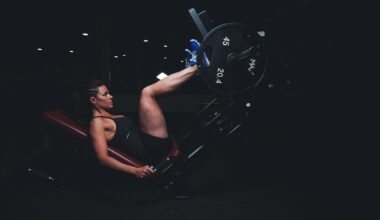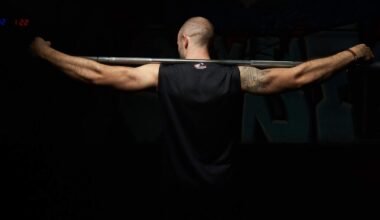Upper Body Workouts Targeting Biceps, Triceps, and Shoulders
Home workouts can effectively build strength in key areas of the upper body, particularly the biceps, triceps, and shoulders. Focusing on these muscles can enhance overall performance in other exercises and activities. To maximize results, adopting a structured workout routine is crucial. Start by incorporating compound movements that engage multiple muscle groups. Exercises like push-ups, dumbbell presses, and overhead presses target the chest and shoulders while working the arms. You can also add isolation exercises to specifically focus on each muscle group. For the biceps, try curls with dumbbells or resistance bands. To focus on triceps, implement dips or tricep kickbacks. These exercises can be adjusted based on your available equipment and strength level, ensuring you continuously challenge yourself. Effective workouts should ideally be 30-45 minutes long, allowing enough time for proper warm-up and cool-down. Additionally, it’s important to include variety to keep workouts fresh and motivate consistent practice. Monitoring progress and setting achievable goals can enhance the workout experience and foster a sense of accomplishment. Keep pushing, and over time, significant strength gains will manifest!
The Importance of Warm-Up in Upper Body Workouts
Before diving into upper body workouts, incorporating a proper warm-up is essential. A well-structured warm-up increases blood flow to the muscles and helps prevent injury. Aim for at least 5-10 minutes of dynamic stretching or light cardio. Dynamic stretches can include arm circles, torso twists, and shoulder rolls, which ensure that your muscles are adequately prepared for the demands of resistance training. It’s vital to dedicate time to warm up the muscles surrounding the shoulders, biceps, and triceps before moving into heavier lifts. This preparation phase enhances muscle elasticity and range of motion, contributing to the effectiveness of the subsequent workout. Additionally, including mobility exercises in your warm-up routine can further improve joint function, which is crucial for performing movements correctly and safely. Always prioritize form during workouts to avoid injuries caused by improper techniques. Listening to your body during warm-ups can also help you gauge your readiness for the workout ahead. If something feels off, it may be wise to adjust your plan for the day. A diligent warm-up routine provides a solid foundation for a successful upper body workout regimen. It primes both your body and mind for a fruitful session.
When creating an upper body workout program targeting biceps, triceps, and shoulders, be sure to include balanced exercises to cultivate strength. Compound exercises like push-ups, dumbbell bench press, and shoulder press are excellent for targeting multiple muscle groups. In addition to these, isolation exercises will enable you to focus specifically on the biceps and triceps. For the biceps, consider exercises like hammer curls, concentration curls, or resistance band curls for a comprehensive workout experience. The triceps can be engaged with exercises like overhead tricep extensions or close-grip bench presses, thereby emphasizing strength development in this area. Shoulders are a crucial muscular group; include lateral raises, front raises, and upright rows to build a well-rounded routine. These exercises ensure balanced muscle development while reducing the risk of overuse injuries. You may also want to change your grips or stances during these exercises to target different aspects of the muscles. Commit to a solid upper body workout structure, allowing for adequate recovery time between sessions. Over time, regularity and progressive overload will yield noticeable improvements in muscle strength and tone, enhancing your physique and overall fitness.
To ensure well-rounded development, it’s important to vary your upper body workouts targeting the biceps, triceps, and shoulders. Changing exercises frequently keeps the muscles guessing and promotes continued growth. Consider rotating between dumbbell, barbell, and bodyweight exercises or utilizing resistance bands for added variety. You can also adjust the number of sets and repetitions,. Remember that lower weight with higher repetitions can improve muscular endurance, while heavier weights with lower repetitions focus on strength. A general recommendation for average fitness enthusiasts is 3-4 sets of 8-12 repetitions for each exercise. Always prioritize form over the weight lifted to ensure safety and maximize benefits. It’s also helpful to maintain a workout log to track your progress, documenting the weights used, sets completed, and personal records achieved. Celebrate small victories, as they accumulate over time into significant improvements in strength and physique. This approach fosters motivation and accountability, further enhancing your routine’s success. Staying committed ensures you reap the full benefits of every session, and this consistency will contribute significantly to your overall fitness journey.
Incorporating Rest and Recovery
The role of rest and recovery in any upper body workout routine cannot be overstated. Muscles need adequate time to recover and repair after rigorous training; this is where growth happens. Aim for at least 48 hours of rest before targeting the same muscle group again. Although it might be tempting to work out every day, recovery is equally important for achieving optimal results. Active recovery on rest days, such as light yoga or gentle stretching, can enhance flexibility and blood flow, aiding the muscle repair process while keeping the body engaged. Additionally, prioritizing sleep is crucial; aim for 7-9 hours of quality sleep each night to support muscle recovery and overall health. Staying hydrated and following a balanced diet rich in protein also accelerates the recovery process. The same goes for post-workout nutrition; consuming a protein-rich snack after an intense workout will help facilitate muscle repair. Keeping track of your body’s signals is essential as well; if you experience persistent soreness or fatigue, it may be a sign to take additional rest. Listening to your body can prevent overtraining and ensure sustainable fitness improvement.
To keep your upper body workouts targeting biceps, triceps, and shoulders dynamic, consider employing supersets or circuits. Supersets involve performing two exercises back-to-back with minimal rest, which elevates the heart rate and improves endurance. For example, pair bicep curls with tricep dips to maximize efficiency during your workout. This approach can also save time, fitting more into a shorter session. Incorporating circuit training allows you to work multiple muscle groups while promoting cardiovascular fitness. Design a circuit that targets your upper body effectively; round up exercises like push-ups, lateral raises, and dumbbell presses, grouping them together. Switching between exercises helps in keeping the workout engaging and will also challenge your muscles in new ways for greater adaptability. You might consider varying the order of exercises weekly or bi-weekly to avoid training plateaus. Additionally, tracking insights from different formats can help determine what works best for you. Lastly, feeling a mix of fatigue and satisfaction post-workout is a powerful indicator of effective sessions. This concept encourages trying new workout strategies, leading to a more enjoyable and ultimately successful fitness regimen.
Conclusion and Commitment
In conclusion, upper body workouts targeting the biceps, triceps, and shoulders provide substantial benefits in terms of strength, aesthetics, and functional performance. Adopting a structured routine that includes comprehensive warm-ups, varied exercises, and appropriate rest can significantly impact muscle development and overall health. Consistency is fundamental; committing to a well-rounded routine while diligently tracking progress fosters improvement and nurtures motivation. Working out from home offers flexibility and convenience, making it accessible for everyone to engage in these empowering workouts. As you create your plan, remember that patience is vital. Results take time, and every small effort adds to your fitness journey. Embrace the learning curve by experimenting with different techniques and formats, allowing for muscle growth while maintaining your interest. Most importantly, the enjoyment derived from doing these workouts will enhance your commitment, ensuring sustainability over time. Encourage your friends or family members to join, as sharing the experience can make it even more enjoyable. Ultimately, personal satisfaction and strength improvements drive the ongoing determination to stick with your upper body workout routine, paving the way for long-term fitness success.


